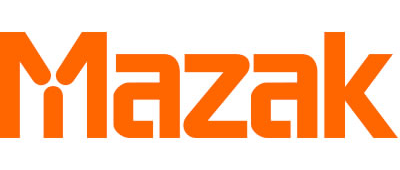
Mazak Corp.'s highly productive Integrex i-300ST multitask machine is available with the company’s spindle health monitoring system. As a revolutionary new tool powered by AI technology, the system monitors spindle health to help minimize unexpected machine downtime.
Developed in collaboration with University of Cincinnati’s IMS Center, Mazak’s spindle health monitoring system’s health check macro program uses edge computing and data analytics based on a proprietary algorithm to create a unique spindle model for each machine. Machine operators can run the program in less than a minute and be
made aware of any spindle issues before they cause complete failure. Shops can then schedule spindle maintenance or replacement in advance of failure to maintain full production capacity. The spindle health can be viewed on the Smooth control or any device connected to the machine network using a web browser.
In addition to spindle health monitoring, the Integrex i-300ST featured two turning spindles, a milling spindle and lower turret – a configuration that can process first and second operations simultaneously or perform required sequential operations on a single workpiece. With the capability to handle all processes from raw material input through final machining, the machine provides significant reductions in lead-times and improves part accuracy through the elimination of multiple setups. Plus, its full 5-axis capability makes it possible to easily process fully prismatic parts from solid block or castings, round parts or highly contoured sculptured parts.
The machine’s main horizontal turning spindle with a 10" chuck is capable of C-axis indexing in 0.0001-degree increments. The main turning spindle is a 40-hp integral spindle motor that provides a 4,000-rpm maximum spindle speed, while the second, opposed headstock with a 10" chuck features a 35-hp integral spindle motor and 4,000-rpm top speed.
Additionally, a 30-hp, 12,000-rpm integral motor milling spindle rotates in the B-axis throughout a range of +210 and -30 degrees from vertical. The milling spindle also travels a generous 10.24" in the Y-axis. For increased versatility, the Integrex i-300ST accommodates workpieces up to 25.9" in diameter and 59.8" long. It is also able to meet the machining requirements of a wide variety of workpieces thanks to its tool magazine capacities, from the standard 36 tools up to the maximum of 110 tools.
The machine’s lower drum turret accommodates nine tools and can work at either the main or second spindle with the same tool. This makes it possible for the turret to perform balanced cutting operations on one part working in tandem with the machine’s vertical milling spindle. There is also the option for milling capability with the lower turret.
All of which provides the flexibility to process a workpiece’s second operation in the machine’s second spindle or to perform first and second operations simultaneously on one workpiece.
The Integrex i-300ST sports the new Mazatrol SmoothX CNC that is a key element – along with new machine hardware and servo systems – of Mazak’s Smooth Technology. As a dramatic evolution in the advancement of machine tools, Smooth Technology is a complete process-performance platform that spans the entire part-production landscape from programming and setup to metal-removal operations and automation to monitoring and data collection/transfer.
Contact Details
Related Glossary Terms
- chuck
chuck
Workholding device that affixes to a mill, lathe or drill-press spindle. It holds a tool or workpiece by one end, allowing it to be rotated. May also be fitted to the machine table to hold a workpiece. Two or more adjustable jaws actually hold the tool or part. May be actuated manually, pneumatically, hydraulically or electrically. See collet.
- computer numerical control ( CNC)
computer numerical control ( CNC)
Microprocessor-based controller dedicated to a machine tool that permits the creation or modification of parts. Programmed numerical control activates the machine’s servos and spindle drives and controls the various machining operations. See DNC, direct numerical control; NC, numerical control.
- gang cutting ( milling)
gang cutting ( milling)
Machining with several cutters mounted on a single arbor, generally for simultaneous cutting.
- milling
milling
Machining operation in which metal or other material is removed by applying power to a rotating cutter. In vertical milling, the cutting tool is mounted vertically on the spindle. In horizontal milling, the cutting tool is mounted horizontally, either directly on the spindle or on an arbor. Horizontal milling is further broken down into conventional milling, where the cutter rotates opposite the direction of feed, or “up” into the workpiece; and climb milling, where the cutter rotates in the direction of feed, or “down” into the workpiece. Milling operations include plane or surface milling, endmilling, facemilling, angle milling, form milling and profiling.
- turning
turning
Workpiece is held in a chuck, mounted on a face plate or secured between centers and rotated while a cutting tool, normally a single-point tool, is fed into it along its periphery or across its end or face. Takes the form of straight turning (cutting along the periphery of the workpiece); taper turning (creating a taper); step turning (turning different-size diameters on the same work); chamfering (beveling an edge or shoulder); facing (cutting on an end); turning threads (usually external but can be internal); roughing (high-volume metal removal); and finishing (final light cuts). Performed on lathes, turning centers, chucking machines, automatic screw machines and similar machines.
- web
web
On a rotating tool, the portion of the tool body that joins the lands. Web is thicker at the shank end, relative to the point end, providing maximum torsional strength.







